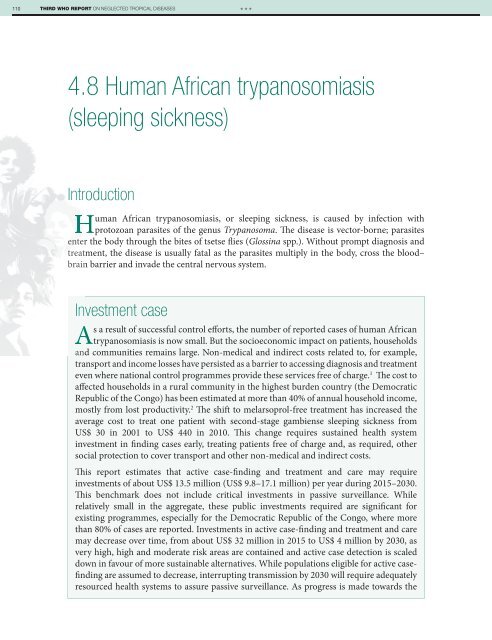1A9bnbK
1A9bnbK
1A9bnbK
You also want an ePaper? Increase the reach of your titles
YUMPU automatically turns print PDFs into web optimized ePapers that Google loves.
110 THIRD WHO REPORT ON NEGLECTED TROPICAL DISEASES<br />
***<br />
4.8 Human African trypanosomiasis<br />
(sleeping sickness)<br />
Introduction<br />
Human African trypanosomiasis, or sleeping sickness, is caused by infection with<br />
protozoan parasites of the genus Trypanosoma. The disease is vector-borne; parasites<br />
enter<br />
the body through the bites of tsetse flies (Glossina spp.). Without prompt diagnosis and<br />
treatment, the disease is usually fatal as the parasites multiply in the body, cross the blood–<br />
brain<br />
barrier and invade the central nervous system.<br />
Investment case<br />
As a result of successful control efforts, the number of reported cases of human African<br />
trypanosomiasis is now small. But the socioeconomic impact on patients, households<br />
and communities remains large. Non-medical and indirect costs related to, for example,<br />
transport and income losses have persisted as a barrier to accessing diagnosis and treatment<br />
even where national control programmes provide these services free of charge. 1 The cost to<br />
affected households in a rural community in the highest burden country (the Democratic<br />
Republic of the Congo) has been estimated at more than 40% of annual household income,<br />
mostly from lost productivity. 2 The shift to melarsoprol-free treatment has increased the<br />
average cost to treat one patient with second-stage gambiense sleeping sickness from<br />
US$ 30 in 2001 to US$ 440 in 2010. This change requires sustained health system<br />
investment in finding cases early, treating patients free of charge and, as required, other<br />
social protection to cover transport and other non-medical and indirect costs.<br />
This report estimates that active case-finding and treatment and care may require<br />
investments of about US$ 13.5 million (US$ 9.8–17.1 million) per year during 2015–2030.<br />
This benchmark does not include critical investments in passive surveillance. While<br />
relatively small in the aggregate, these public investments required are significant for<br />
existing programmes, especially for the Democratic Republic of the Congo, where more<br />
than 80% of cases are reported. Investments in active case-finding and treatment and care<br />
may decrease over time, from about US$ 32 million in 2015 to US$ 4 million by 2030, as<br />
very high, high and moderate risk areas are contained and active case detection is scaled<br />
down in favour of more sustainable alternatives. While populations eligible for active casefinding<br />
are assumed to decrease, interrupting transmission by 2030 will require adequately<br />
resourced health systems to assure passive surveillance. As progress is made towards the


